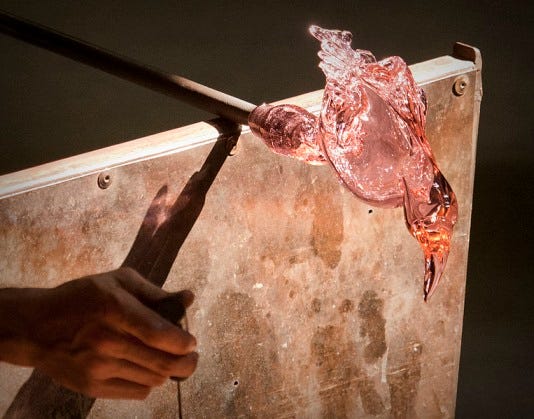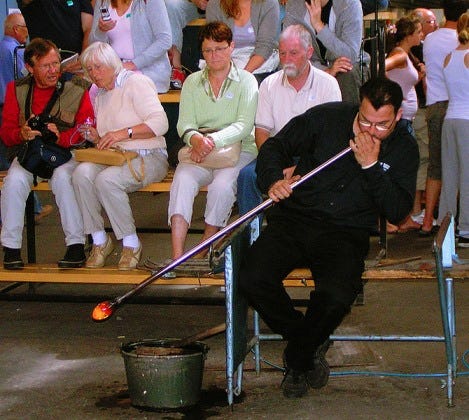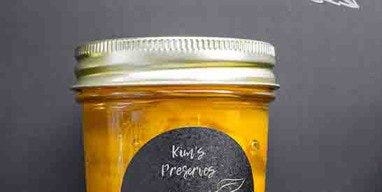The Glass Blown Bottle
Article By : Jonathan @ BottleStore

[Photo by DDauri (Wikimedia Commons) ]
Glassblowing as an art form appears to have begun on the Phoenician coast in the Middle East in 20 B.C., and from there, it quickly spread as a practice that created objects valuable in both form and function. In the ruins of Pompeii, useful items such as windowpanes and containers made from glass were both discovered. Later, after the decline of the Roman Empire, the center of glassworking became Constantinople. The manufacturing of mosaics and colored glasses were specialties of the Byzantine glassworkers.
Following the Dark Ages, Venice became an epicenter for glassworking, and by the end of the 17th century, it was home to more than 300 glassworking factories. The Venetians created glass that looked like rock crystal, so they called it "cristallo." Later, glass factories began popping up all over Europe. In 1603, an Englishman named George Ravenscroft performed the first real physical property alterations on glass. Lead oxide was added to the melt, which created a new, more durable glass than Venetian, known as lead crystal glass. Many glassblowing artists today still prefer to utilize this type of glass.
- Glassblowing
- History of Glassblowing: Who Was First?
- Roman Glass-Making
- Glassblowing Defined
- Roman Mold-Blown Glass
How to Blow a Glass Bottle

[Photo by Mogens Engelund (Wikimedia Commons) ]
- Step One: Grab a 4-foot blowpipe made of iron or steel.
- Step Two: Dip the blowpipe into a pot inside a furnace that contains a batch of melted glass. You will now have a glob of molten glass on the end of your blowpipe.
- Step Three: Begin to shape the glass by rolling it on a big, flat surface.
- Step Four: Blow through the tube, which will create a bubble in the glass. (Cap the end of the tube when you are not blowing in order to keep your glass's shape.)
- Step Five: Roll and shape your glass and blow again if needed until you have the bottle shape you desire. There are many different tools that are available to help you with the shaping process. You can also add glass bits or different colorants to your glass at this point.
- Step Six: Attach a metal rod, referred to as a pontil, to the bottom of the blown glass so you can shape the mouth end. (The pontil will leave a mark when you remove it, which you can polish or grind away later.)
- Step Seven: Cool your new glass bottle slowly so it doesn't crack by using an annealer (a special furnace that controls the rate of cooling).
- Step Eight: Once your bottle is completely cooled, you can add special touches to it by grinding, enameling, engraving, or polishing it, among other options.
Glassblowing Techniques
Glassblowing can be performed utilizing the lampwork method or the soft glass method. Lampwork requires a flame, while soft glass utilizes a furnace. Lampwork involves heating glass tubes and shaping them over the open flame of a torch. Next, you heat color and apply it to the tube of glass. You blow into the tube in order to create shapes. Finally, you place your creation into an annealer to evenly heat it and then allow it to cool. Soft glass is the traditional method in which the artist dips a blowpipe into a batch of molten glass and works with it while blowing into it and using various tools. Molds can also be used with the soft glass method. There are single-piece and multi-piece molds; the artist blows the molten glass glob into the mold or molds in order to shape the glass.
Glassblowing Terms and Definitions
- Annealer: A special furnace utilized to control the rate of cooling
- Batch: The ingredients mixed together and used to create the glass object
- Block: A wet piece of wood used as a shaping tool
- Blowpipe: A 4-foot steel or iron rod (typically) that is used to blow air into the glass mixture
- Charging: The process by which a furnace melts the batch inside it at temperatures higher than 2,000 degrees Fahrenheit
- Glory Hole: A furnace used to help keep the glass warm as the blower shapes it
- Jack: A bladed shaping tool
- Marver: A large, flat surface on which you can shape and roll the glass
- Parison: Glass that is partly blown
- Pontil: A metal rod that is attached to the blown glass bottom so the mouth end can be shaped
- Punty: A smaller metal rod used to add glass bits and colorants









